I was bad at math, but I can shoot straight...
I was a reasonably indifferent student at school; Not bad, just not that interested in the pace (lack of pace) they went at. I tended to finish early, get reasonable results then annoy everyone else...Yep, my teachers reported to my parents that I was disruptive to others. Report card time was always an interesting time for me, especially considering my dad taught at the high school I attended.
One of the subjects I was particularly bad at was math. It's not like I was stupid or anything, I just didn't get what all those numbers were going to do to help me later in life. Algebra and calculus...Never used them since. So, considering this you can imagine my surprise, and dismay, when I realised that to do one of my hobbies properly and with great effectiveness math was a critical factor. It was not one of my happiest moments. Of course there are calculation tools that can assist with this particular hobby of mine however to be well-rounded in it I wanted to know how to use my own brain, limited as it may be, to perform the necessary calculations and enable me to proceed.
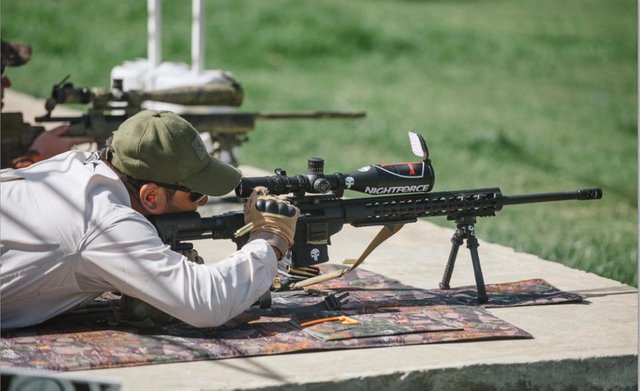
I shoot guns a lot, hand guns and rifles mainly and occasionally shot guns. In hand gun shooting not a lot of math is required. It's a defensive firearm and so generally volume is the order of the day, coupled with some degree of aiming. This is over-simplifying it of course. With the rifle disciplines I shoot it's another matter. I shoot at long ranges, well long for me, out to around 1,600 metres (1.6km or 1 mile for you americans). Target sizes vary from dinner plate sized to about twice that, sometimes smaller though. I'm reasonably good at it although bragging isn't my thing. As I delved deeper into the discipline I learned quite quickly that math is a critical factor of getting the small projectile from the gun to the target with the required accuracy to actually hit it. Damn it, why didn't I pay more attention at school!
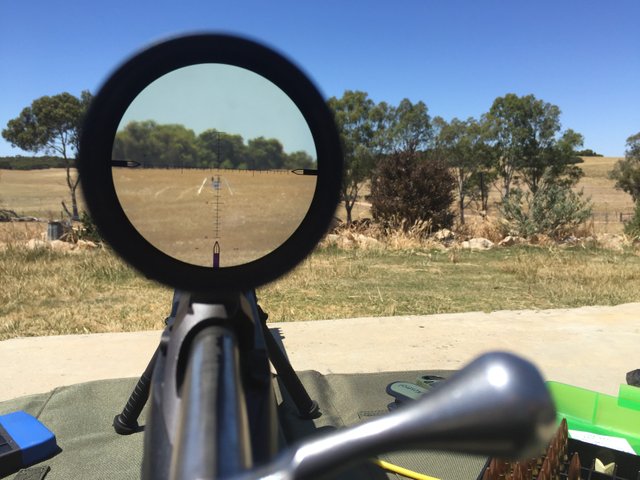
Looking through my MOA scope (Nightforce) at a target 700m away.
Not to worry though, there's ballistics software which I use to combine all of the various parameters and deliver me a field firing solution (FFS) to input to the elevation and windage turrets on my scope effectively allowing me to impact the target. This, of course, is only as good as the information that goes into it and if that's wrong, my wind call for instance, I'll probably miss. Further to that, accuracy at that sort of range isn't a point-and-shoot sort of thing. Many things combine to get that little lead projectile all the way down range to impact upon the steel target (or whatever) it's shot at. I use StrelokPro and Applied Ballistics for my ballistics calculators although there are others.
Some of the information required to input to a ballistics calculator include: Rifle twist rate, barrel length, ammunition overall-length, muzzle velocity (MV is the speed the bullet exits the muzzle), standard deviation (average MV difference calculated over several rounds), projectile weight, projectile ballistic-coefficient, gunpowder type, the scope height over the barrel, the reticle type etc. On top of that to calculate the FFS, (the amount of elevation and windage required to make the shot) environmental factors need to be plugged in. These are things like: Temperature, altitude and humidity plus wind speed and direction. I have a weather meter that calculates temp, humidity and altitude into one measurement called Density Altitude to make it a little easier for me. I read the wind speed and direction with my eyes, face, tree and grass movement etc...The direction (Azimuth) being shot also plays a part as does the turning of the earth, the Coriolis effect. At long range a bullet leaves the earth, which then turns independently from the bullet, moving the target away from the bullet that only ever travels on the trajectory it started on. Spin drift is also calculated plus hydraulic lift, the slope-angle of the shot and so on...
So, there's really a lot involved and that doesn't even include the breathing and trigger-pull process, rifle grip, technique of loading the bipod and more...Plus making the ammunition in the first place, which I do myself.
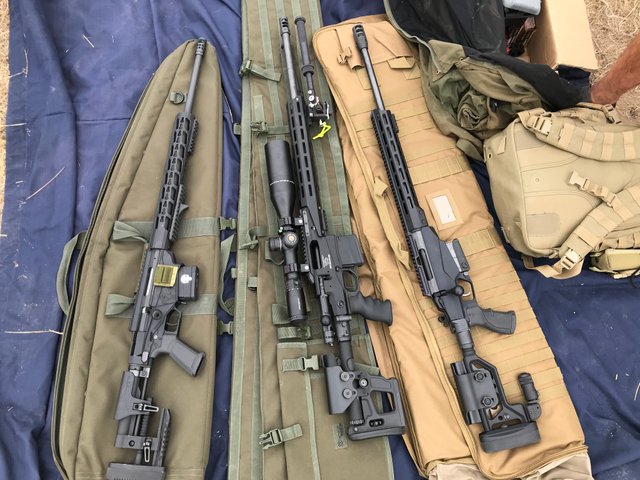
It's really a bit of a science and as I said above it's made a little more achievable with the use of a correctly set up ballistics calculator and the correct load data (Ammunition load-data). But what happens when the battery runs out on the ballistics calculator (a phone app these days), or when the phone breaks or falls down the cliff or into the river? Well, have backup batteries or device I guess, like any well prepared person would...Or take the shot using your known data, commonly called DOPE. (Data on previous engagements) Some of my equipment pictured to the right.
DOPE is information recorded every time a bullet is fired. (At least that's what I do.) I record every piece of information I can. The fall of shot on the target, range, ALL the environmental factors, direction of shot, slope-angle, the FFS used (what I dialled into the turrets on the scope), the date, time and place...Everything. That data then gets collated into a DOPE chart that I can use at a later date if I have to make very rapid shots where in-putting data to the ballistics app is not viable...In a competition for instance. I present that data to myself in various ways, typically on what's called an armboard. It's done in various ways though. If you watch the movie American Sniper you'll see some examples.
So, despite all that technical stuff it's really quite satisfying to impact something you can't see with the naked eye. Sometimes, depending on the calibre and projectile flight time, can be seconds, then there's that wait to hear the sound of the bullet striking the steel come back to one's ears. So satisfying. Of course, depending on what the target is the sound of the impact may not travel back.
It's all calculations and math really. Measurements generally are. I haven't even mentioned about the different measurements used for the turret adjustments. The most common two are MOA and MRAD.
MOA means Minute of Angle and is 1/60th of a degree. At 100 yards 1MOA is 1 inch (1.047 actually) and at 800 yards 1MOA is 8 inches. The measurement of 1MOA is always called just that, the actual size of it changes though, with range. It's essentially two diverging lines starting at a point. The two lines diverge as they get farther away. 1MOA at 400 yards is 4 inches, 500 is 5 inches etc.
MOA is used as the measurement to adjust the turrets on the elevation and windage of the scope, usually in 1/4 inch clicks. 4 clicks up equals 1MOA. This would change the point of impact by 1 inch higher at 100 yards for instance. Getting all of this?
MRAD, or milradian is another method. 1 MRAD is essentially one-thousandth of a radian (0.001). I'll not go into it here as it gets pretty heavy. You can see on the image below my Kahles MRAD scope uses 1/10 adjustments. MRAD is considered more accurate for this reason although there are people who would argue that.
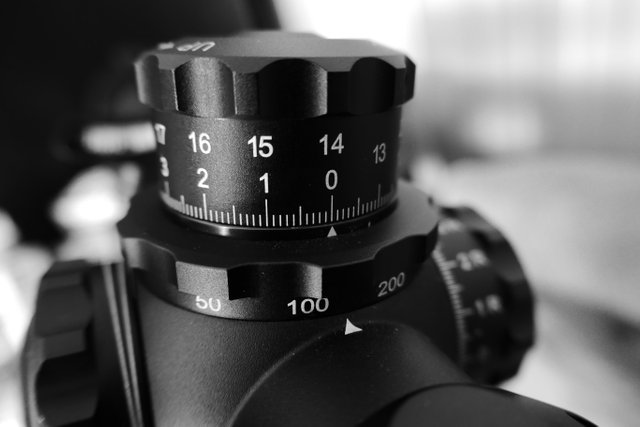
I use both MOA and MRAD (or Mil as it's often called) depending on what gun/scope combination I am shooting. Both have their advantages and shortfalls although I prefer MRAD myself, maybe because my best scope (Kahles 624i) is MRAD and it's awesome. It'd want to be for $3,800 I guess though. This image shows my Kahles elevation turret with its MRAD adjustments. You can see it set on zero elevation. It goes all the way up to 26MRAD.
So, to bring that all together (somehow) let's say I was shooting at a 1MOA target at 1000 metres (1 kilometre away) That's a 10 inch in diameter target. Let's assume I am using a 6mm calibre rifle and an 87grain weight projectile achieving 2950fps MV. (feet per second). There's also a 4mph full value wind (Full value means 90 degrees or 9 oclock or 3 oclock on a clock face) I would need to input 11.6Mil of elevation into the scope and 1.3Mil of right windage. If I aimed the scope crosshairs at the target and did all the necessary protocols for correct firing it would hit. Flight time to the target is 1.95 seconds. Simple.
Obviously there's a lot of information missing from the above example. It actually assumes an environmental situation from my last shot, not actual environmentals from my lounge room where I am writing this. I say this for the purists who may question the FFS.
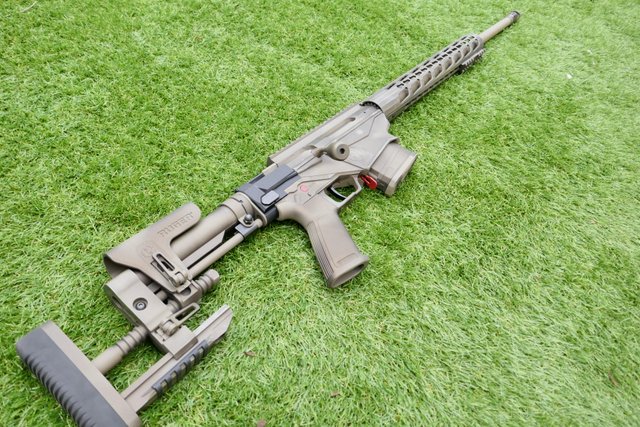
Phew, Well, there's a very VERY basic explanation as to why I should have paid more attention in math class. To be honest I am far from bad with math but I'm also a long way from great. I have devised, in conjunction with one of my friends a calculation I can do in my head to calculate an FFS based purely on the wind call and range being shot. It's quite a simple mathematical calculation and works effectively out to 700m. I have got one for MOA calculations (if I'm using an MOA scope) and also MRAD although the MRAD one is more complicated. I would generally defer to obtaining my FFS from the ballistics software where possible.
When I'm in the field I have spare batteries for everything, and spares for the spares. I have a back up device and then my DOPE charts which assume density altitudes (DA) from -250m to +1500 so I have a better chance of having the right DOPE. You may ask why I need a DA down to -250m below seal level as I'll never be shooting in those conditions however sometimes the DA gets that low and more. Oh, just to explain, the DA brings temperature, altitude and humidity together into a number. Lets say 500. That means the environmental conditions are having the same effect on the bullet that me shooting at an altitude of +500m would. I think maybe I didn't explain that before. At higher altitude the air pressure is lower so it creates less drag on the bullet making it slip through the air better, requiring less elevation input to the scope. Got it?
Ok, so there's no test or homework. So don't worry. I merely write these types of blogs to demonstrate that shooting isn't something that involves a gun, bullets, beer and a red neck. To do it well, effectively, it takes effort, skill and some understanding of physics, math and I'm going throw chemistry in as gun powders are involved.
So, thanks for reading. If any of you are still here, and awake well done!
See, if they'd taught it like that...well, I wouldn't have been quite so bad. Maybe. Hopefully. If they told you you could use math later on to do cool stuff like shoot a gun, way more kids would listen, I'm pretty sure.
Also, I love the target picture (scope picture?) :D
Yep, scope picture/sight picture...Well done. :)
Okay my brain hurts now, I only understood part of that XD (well I understood all the words, just not in that context lol). I knew there was maths and chemistry involved in shooting but this is insane x_x I've decided all long range shooters are mathematical geniuses now XD
Although seeing as it was something that you're interested in, you probably picked it all up a hell of a lot quicker than you would have done in school even if you had been paying attention and trying your hardest :)
Haha, yes it's a bit complex. In person I could explain it must be easier and faster. It's not all that difficult when laid out before you. I don't know if we're math genius-level but there's certainly some pretty complicated processes. The fun part is that moment when the bullet strikes the target. All that work and effort comes together and...IMPACT.
Hello pretties, the DOPE sounds useful. Well it all sounds useful haha. Time to hone some mathematics... bleh
I thought you'd like this one... :)
Extremely outstanding post, my friend! You have successfully scared me away from long distance shooting! Lol. Seriously though, i just assumed it was all done by computers. I really learned a lot.
The most we ever shoot is about 150 to 200 yards and that is rare. We qualify on our rifles out to 100 yards down to 15 yards where we transition to our handgun.
It's a rewarding thing to reach out that far with that much accuracy but it takes effort and money. Some degree of success can be achieved with less though of course, but it's not as repeatable and in this form of shooting the first bullet really needs to count generally.
I've spent a long time learning to read the wind and am usually +/- 1 mile an hour accurate (mostly) and my data is very accurate, I mean my muzzle velocities are recorded accurately and the ammunition I reload is done meticulously as is the load development to determine the right load and the rifles node in the first place. I like the technical aspect, but that all culminates in the shot and impact which is why it's done in the first place. Al my equipment is the best I can buy too...And I'm always open to learn.
If you get a book called Accuracy and Precision for long range shooting by Bryan Litz it'll give you a better idea than I ever could. You could also YouTube it.
https://www.youtube.com/user/TiborasaurusRex hers a good place to start. tiborasaurusrex does some great stuff.
Fascinating information. How do you account for wind gusts? Does it make that much of a difference?
Great question.
So, typically I'd wait for a lull back to the wind call I'd made initially or I would simply re-calculate the wind and hold over for that new wind speed. Remember I can make these calculations in my head out to certain distances. If I feel the wind pick up I read it on my face, the trees etc and account for it. Same as if it drops off. I shift point of aim and hold over less.
The worst wind I shot in was 25mph but I still made the shot. This was in a noncompetitive situation of course so I had the time. In a competition then working off an average wind speed and bracketing the target is the only way to do it, that I know of. This essentially means aiming for a point on the target that will still give me an impact even if the wind was going to pick up. Lets say the wind was full-value (3 oclock). I would hold on the inside edge of the plate (gong) using the wind call for the slowest wind I called. That way it'll impact if the wind stays that speed. If it gusted up and shifted my bullet left in-flight then there's still plenty of gong for it to land on. That's the theory. Make sense? It increases the hit factor. Of course if it gusted to 10mph more than expected a miss may result.
I'm sure there's other ways to do it but I'm not a SEAL Sniper and I don't know them. Lives don't depend on my shots. They may in a zombie apocalypse, but not yet.
The other thing is that at long range the wind can be going one way at 400m, the other way at 900m and a totally new way or speed at 1400m. Depends on the terrain but I shoot somewhere that does this. To make that 1400m shot I scope it and read/call the wind at three different ranges. Say, where I am which is easy, half way and then at the target. I use trees, grass, dust picked up, cows tails blowing, mirage...Anything I can. This needs to be done accurately and quickly in a competition.
Let's say I get 5mph, 7mph and 10mph. I'd use 7mph as my wind call. I might favour a particular spot on the gong, bracketing again. Let's say it's going another direction then bracket a little more. Keeping in mind that the bullets I use are very slippery so are not affected by the wind too much. This helps. They are also buzzing along. It will get affected more by the wind as it slows and arcs into the target so that wind call is quite critical. The one near the target. It's all critical though.
Remember that 1000m shot from the post as below?
1.3Mil to the right was the windage dial or holdover with the 4mph wind right? I just threw in 14mph wind also full value into the same calculation and the windage holdover is now 5.1Mil right. Big difference right? This is where bracketing comes in.
I am not expert though, so someone may have other techniques. I hope this helps @papacrusher
Really excellent explanation! I am familiar with bracketing(didn't know the name for it..lol) because of the rare chance a sight is off during qualifying I can adjust my aim to ensure a score regardless of the sight. I also teach this to my guys as far as aiming at the widest part of the human silhouette target because if you are slightly off, you still have a scoring shot.
My next question was going to be about various windpeeds at the distances between you and the target and how you factor that in, but you covered that very well also.
I can run another wind scenario if you like...24mph at 1000m same scenario...8.9Mil right hold.
It's still an achievable shot.
Thanks, I tried to make it simple, not that you're simple, only that I don't always have the words to explain it.
I find this stuff fascinating and yet people watch American Sniper and thing you just point and shoot. Still, better not everyone knows this stuff I guess.
Oh trust me, when it comes to math, I am as simple as they come! lol I feel fortunate to only be shooting out to 200 yards! The only thing I really have to pay attention to is breathing and trigger pull and that is usually only when shooting while standing or kneeling. Well, I do have to make a slight sight picture adjustment because my red dot sight is sighted for 100 yards, but it becomes automatic muscle memory after running so many rounds through a weapon.
I'd love yo come out and do some work with you. I've not done any AR15 shooting as they are regulated here. Would really love to learn some urban stuff. Long range is one thing, IPSC I'm all over it already but that urban stuff with an AR15...That interests me. Nowhere here to do it though. Maybe one day I'll make a trip and you can get me on the range. That would be awesome.
Army Pic ?
I upvoted your post.
Best regards,
@Council
Posted using https://Steeming.com condenser site.
Hi @galenkp!
Your post was upvoted by @steem-ua, new Steem dApp, using UserAuthority for algorithmic post curation!
Your UA account score is currently 4.255 which ranks you at #2529 across all Steem accounts.
Your rank has improved 9 places in the last three days (old rank 2538).
In our last Algorithmic Curation Round, consisting of 434 contributions, your post is ranked at #103.
Evaluation of your UA score:
Feel free to join our @steem-ua Discord server
You got a 28.33% upvote from @ocdb courtesy of @galenkp!